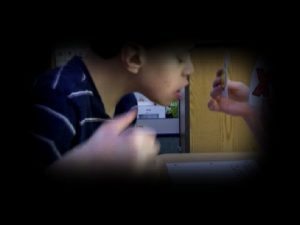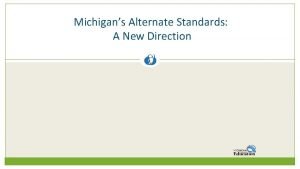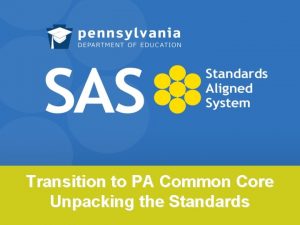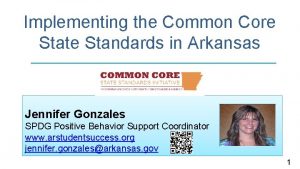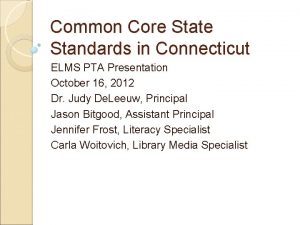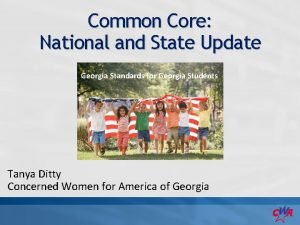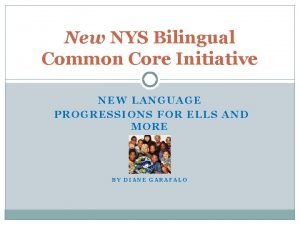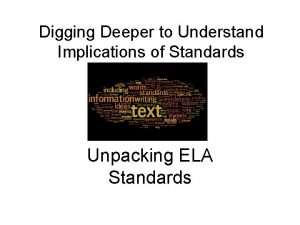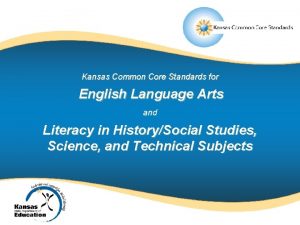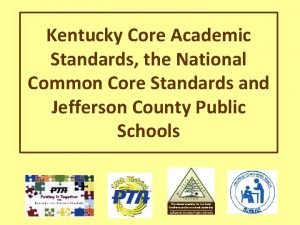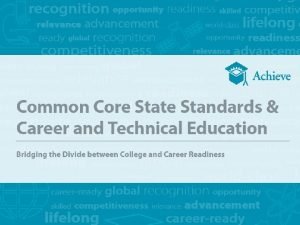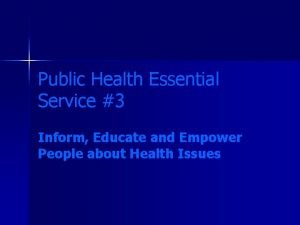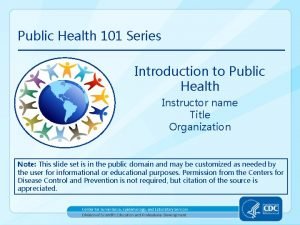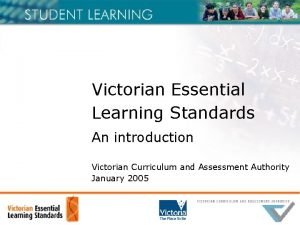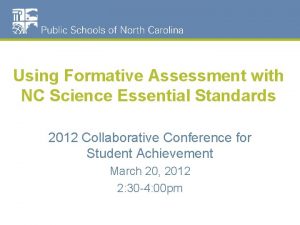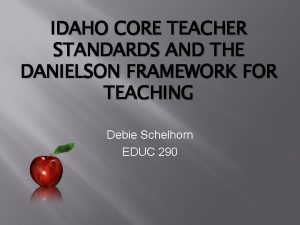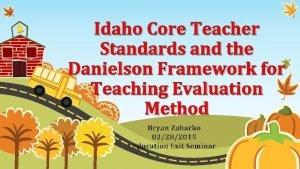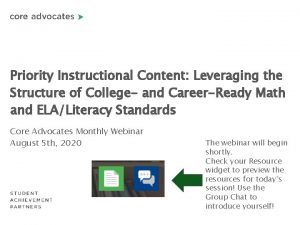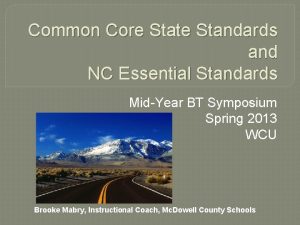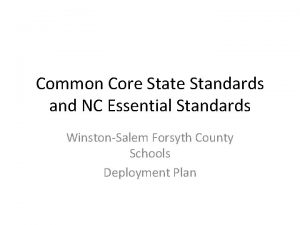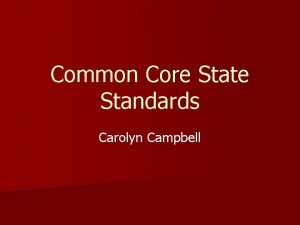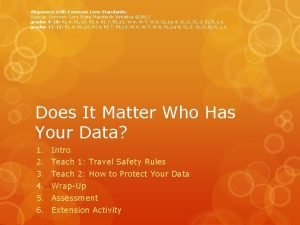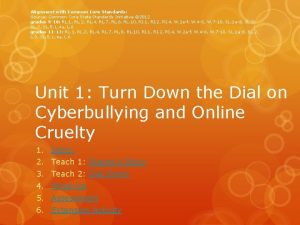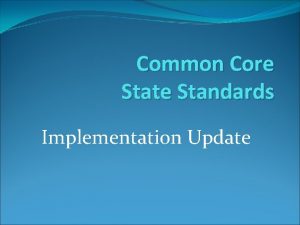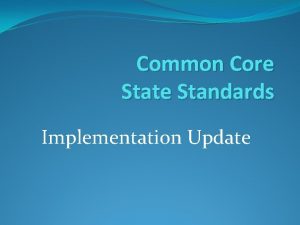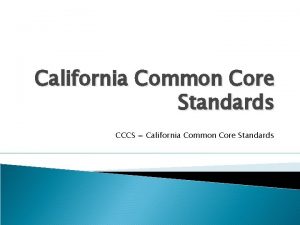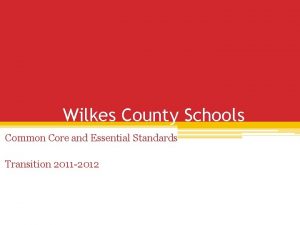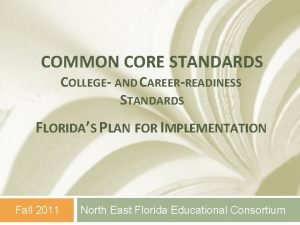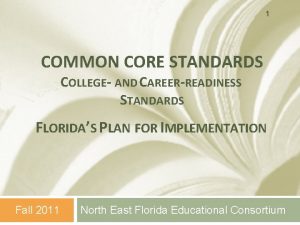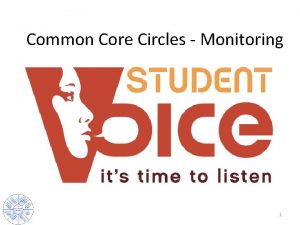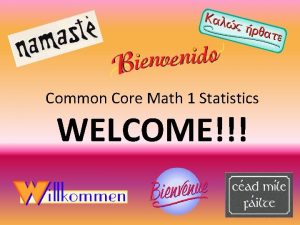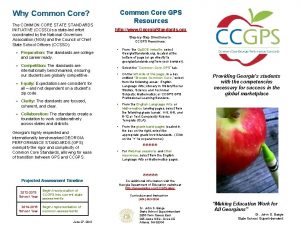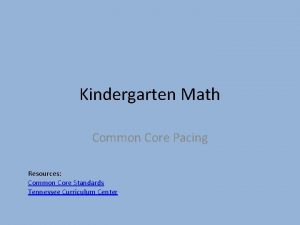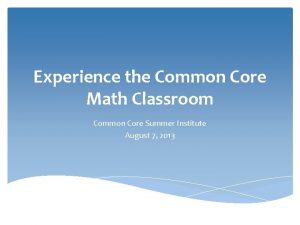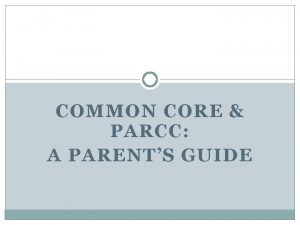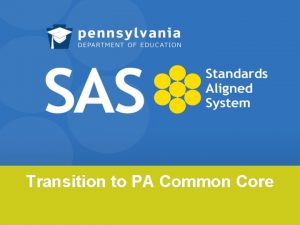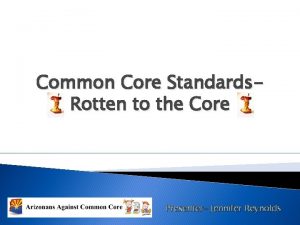Common Core and Essential Standards Preplanning May 5
































- Slides: 32

Common Core and Essential Standards Pre-planning May 5, 2011

Time Line ERPD 4/13 Structure/framework of standards (vocabulary); spiraling continuum 8 practices for math 7 College and Career Readiness capacities for the literate individual/32 anchor standards Crosswalks—just get a copy (exploratory in PLCs) CRW Planning 4/15 & 5/5 (½ days 11: 30 – 3: 30) TNL 1329 CRW Digging deeper in all areas Crosswalks Unpacking documents Operational definitions 8 practices for math 7 College and Career Readiness capacities for the literate individual/anchor standards Begin the work of vertical alignment for one strand (have Tiff Britt’s draft documents) Structure framework – spiraling continuum K-2 math first audit of existing PAs (document what will match and what will need to be changed) Background info and research from Focus Crosswalks Deeper understanding of structure/framework of standards (vocabulary) 8 practices for math ELA – informational text Vertical alignment – spiraling (divide groups by strand & let each group develop) K-2 (Math only)–audits of existing PAs Start K-2 – revamping CGs ELA – revamping CGs 3 -5 discussion on cursive —where does it fit? K-2 math – audits of Envision program CRW Planning Group Fall ‘ 11 What do the performance tasks look like? Unpacking of the standards K-2 – revamping CGs ELA – revamping CGs ERPD 2011 -12 Informational Text PLC teams work to develop unit plans to be shared electronically Resource audit of Envisions for 3 -5 math (in PLCs also? ) Resource audit for 6 -12 math programs

Direction for Today 1. Look at vertical alignment – spiraling documents 2. Review operational definitions 3. Dig into the unpacking documents • K-2 Math review PAs, Science and Social Studies begin to make some connections between reading info. texts and writing anchor standards with current SCOS)

Deliverables for Today 1. 2. 3. 4. 5. Master copy of vertical alignment review Feedback on Curriculum Guide template Implications for CRW K-2 Math PA with change items indicated Connection documents science/social studies

Vertical Alignment

Kudos to Tiffany Britt

Vertical Alignment - Are we heading in the right direction? ELA and Math • In your assigned group, review your assigned domain(s) to determine verification of alignment • Capture any changes on a Master document (include team member names at top) to turn in before leaving

Math Groupings Counting and Cardinality Operations and Algebraic Thinking Number and Operations Base Ten Grades K, 2, 4 Measurement and Data Geometry All Domains Grades 1, 3, 5 Grades 6 -8 Grades 9 -12

ELA Groupings Literature Anchor Standards 1 -10 Grades K, 7, 11 Informational Text Anchor Standards 1 -10 Grades 2, 8, 10 SS Reading Foundational Skills Standards 1 -4 Grades 1 and 4 Writing Anchor Standards 1 -10 Grades 5, 9, Science Speaking and Listening Anchor Standards 1 - Grades 3, 6, 12 6 Language Anchor Standards 1 -6

Operational Definitions

Common Core Model of Text Complexity Dimensions of text complexity, such as levels of meaning, structure, language conventionality and clarity, and knowledge demands. Measures of text complexity, such as word frequency and sentence length, which are typically measured by computer software. Students' knowledge, motivation and interests.

Meaningful Metaphors Element Literal Pattern Abstract Relationship Literal Pattern Element Heart Blood from veins pumps through the superior vena cava Pump moves liquid through a system to make an exchange. Refrigera nt is pumped through a coil. . . Heat Pump

Your Turn Element Text Complexi ty Literal Pattern Abstract Relationship Literal Pattern Element

Informational Text To survive and succeed in the Information Age, students need to learn how to find the information they need and how to evaluate the information they find. Students will have to become effective information seekers and develop as critical readers.

“Bend to Boom” Bend to boom and attach outhaul. Secure tack to gooseneck and attach main halyard. Hoist mainsail while making sure battens are in their pockets. Sail will not go into masthead if vang, mainsheet, or outhaul are not loose. Directions: Please read and write a 2 sentence summary.

Balanced Literacy Balanced literacy is a framework for providing opportunities for students to talk, listen, read, write, and interact with a variety of texts including: • Teacher read aloud • Independent Reading • Writing Workshop • Guided reading • Reader’s Workshop • Shared reading • Literature Study • Modeling • Word Study

Balanced Literacy (activity) Over the course of a week, what would this look like in your course/grade level? M T W Th F

Integrated Curriculum Work with your table team to complete the T chart. What it is… What it isn’t…

Integrated Curriculum Integrated curriculum is a way to teach students that attempts to break down barriers between subjects and make learning more meaningful to students. Integrating curriculum helps students to make connections between subjects.

Anchor Standards College and Career Readiness Anchor Standards (CCR) • provide broad standards, that define the skills and understandings that all students must demonstrate. • Define literacy expectations for college and workforce readiness and are divided into four strands: Reading, Writing, Speaking and Listening, and Language. Grade Specific Standards • provide additional specificity that define the skills and understandings that all students must demonstrate. • Grade-specific standards define end-of-year expectations and correspond to the same-numbered CCR strand standard.

Anchor Standards Name your graduate! (he or she) Your graduate is getting ready to go to college/enter the work force. If she has mastered your category of anchor standards, what qualities & skills will she possess when she leaves I-SS that will make her successful? List these qualities & skills on your picture.

8 Mathematical Practices The Standards for Mathematical Practice describe varieties of expertise that mathematics educators at all levels should seek to develop in their students. These practices rest on important “processes and proficiencies” with longstanding importance in mathematics education.

8 Mathematical Practices 1. Make sense of problems and persevere in solving them. 2. Reason abstractly and quantitatively. 3. Construct viable arguments and critique the reasoning of others. 4. Model with mathematics. 5. Use appropriate tools strategically. 6. Attend to precision. 7. Look for and make use of structure. 8. Look for and express regularity in repeated reasoning.

Putting the 8 Practices into Practice Create a non-linguistic representation of what a classroom engaged in the 8 mathematical practices: Looks like Sounds like Feels like (to teacher & students)

Reflecting on Our Learning How do these practices: • increase student learning? • improve professional practice?

Unpacking Documents

Digging into the Standards • In groups K-2, 3 -5, 6 -8, 9 -12 review the DPI provided unpacking documents based on our current understanding of unpacking the standards based on our work with Classroom Assessment for Student Learning (CASL) • Review the sample Curriculum Guide Template provided and provide feedback on a Master to be turned in at the end of the session

Where do we go from here?

Where do we go from here? CRW All teams will work on: • digging deeper into the standards • unpacking the standards (academic vocabulary, learning targets, curriculum guides) • vertical alignment/spiraling • K-2 Math Only – Revise PAs to align to new math standards • All other subject areas will review PAs to make any edits noted as major concerns last year—No major revisions

Where do we go from here? ERPD for 2011 -12 • Text complexity • Reading and writing in the content areas • Informational Texts • 8 Math Practices • ELA Anchor Standards

Where do we go from here? Before you leave: What are the other implications that should be considered for CRW? What resources will you need at CRW? What else do you need to know before CRW? What other questions might teachers have?

Deliverables for Today 1. 2. 3. 4. 5. Master copy of vertical alignment review Feedback on Curriculum Guide template Implications for CRW K-2 Math PA with change items indicated Connection documents science/social studies
 Common core essential elements
Common core essential elements Michigan essential elements
Michigan essential elements Pa common core standards
Pa common core standards Common core standards arkansas
Common core standards arkansas Connecticut common core state standards
Connecticut common core state standards Common core standards ga
Common core standards ga Bilingual common core standards
Bilingual common core standards Unpacking standards worksheet
Unpacking standards worksheet Common core state standards missouri
Common core state standards missouri Kansas state standards ela
Kansas state standards ela Kcas standards
Kcas standards Common career technical core
Common career technical core Core functions and essential services of public health
Core functions and essential services of public health Public health 101
Public health 101 Characteristics of lipids
Characteristics of lipids The brittle, rocky outer layer of earth
The brittle, rocky outer layer of earth The crust the mantle and the core
The crust the mantle and the core Purpose of paradox
Purpose of paradox Victorian essential learning standards
Victorian essential learning standards Essential standards
Essential standards Ncdpi science standards
Ncdpi science standards Factors necessary for appropriate service standards
Factors necessary for appropriate service standards Greatest common factor of 18 and 27
Greatest common factor of 18 and 27 Common anode and common cathode
Common anode and common cathode Lowest common multiple of 80 and 60
Lowest common multiple of 80 and 60 Highest common factors and lowest common multiples
Highest common factors and lowest common multiples Lcm of 16 24 and 40
Lcm of 16 24 and 40 Multiples of 9 and 21
Multiples of 9 and 21 Layers of earth from most dense to least dense
Layers of earth from most dense to least dense National core standards in nursing
National core standards in nursing Idaho core standards
Idaho core standards Bryan zaharko
Bryan zaharko Achieve the core priority standards
Achieve the core priority standards
